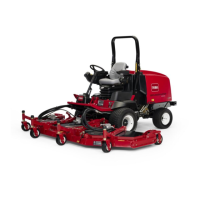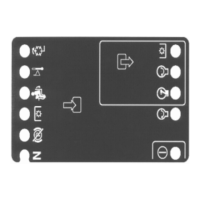Groundsmaster 4100--D/4110--D Hydraulic SystemPage 4 -- 77
Charge Hydraulic System
NOTE: Wheninitiallystartingthehydraulicsystemwith
neworrebuiltcomponentssuchasmotors,pumpsorlift
cylinders, it is important that the hydraulic system be
charged properly. Air must be purged from the system
and its components to reduce the chance of damage.
IMPORTANT: Change hydraulic oil filter whenever
hydraulic components are repaired or replaced.
1. Park machineona levelsurface.Lower cuttingdeck
to the ground, stop engine and engage parking brake.
Remove key from the ignition switch.
2. Make sure all hydraulic connections,lines and com-
ponents are tight.
3. Ifcomponentfailurewassevereorthesystemiscon-
taminated, flush and refill hydraulic system and reser-
voir (see Flush Hydraulic System in this section).
4. Make sure hydraulic reservoir isfull.Addcorrecthy-
draulic oil if necessary.
5. Check control rod to the piston (traction) pump for
proper adjustment, binding or broken parts.
6. Disconnect w ire harness connector from enginerun
solenoid to prevent the engine from starting.
7. Make sure traction pedal and lift control lever are in
theneutralposition.Turnignitionkeyswitchandengage
starter for ten (10) seconds to prime the traction and
gearpumps.Waitfifteen(15)secondstoallow thestart-
er motor to cool and then repeat cranking procedure
again.
8. Connect w ire harness connector to engine run sole-
noid.
WARNING
Beforejackingupthemachine,reviewandfollow
Jacking Instructions in Chapter 1 -- Safety.
9. Raise one front and one rear wheel off the ground
and place support jack stands under the frame. Chock
remainingwheelstopreventmovementofthemachine.
10.Make sure traction pedal and lift control lever are in
neutral. Start engine and run it at low idle (1400 RPM).
Thechargepumpshouldpickupoilandfillthehydraulic
system.Ifthereisnoindicationoffillin30seconds,stop
the engine and determine the cause.
11.Afterthehydraulic system starts to show signsoffill,
actuate lift control switch so that the lift cylinder rod
moves in and out several times. If the cylinder rod does
not move after fifteen (15) seconds or the pump emits
abnormal sounds, shut the engine off immediately and
determine cause or problem. Inspect for the following:
A. Loose filter or suction lines.
B. Blocked s uction line.
C. Faulty charge relief valve.
D. Faulty gear pump.
12.If cylinder does move in fifteen (15) seconds, pro-
ceed to step 13.
13.Operatethetractionpedalintheforwardandreverse
directions. The wheels off the ground should rotate in
the proper direction.
A. If the wheels rotate in the wrong direction, stop
engine and check for proper hose c onnections at
traction pump and motors. Correct as needed.
B. If the wheels rotate in the proper direction, stop
engine.
14.Adjust traction pedal to the neutral position.
15.Check operation of the traction neutral switch.
16.Remove jack stands from frame and lower machine
to the ground. Remove chocks from remaining wheels.
17.If the piston (traction) pump or a wheelor axle motor
was replaced or rebuilt, run the machine so all wheels
turn slowly for ten (10) minutes.
18.Operate machine by gradually increasing it’s work
load to full over a ten (10) minute period.
19.Stop the machine. Check hydraulic reservoir and fill
ifnecessary.Checkhydrauliccomponentsforleaksand
tighten any loose connections.
Hydraulic
System

